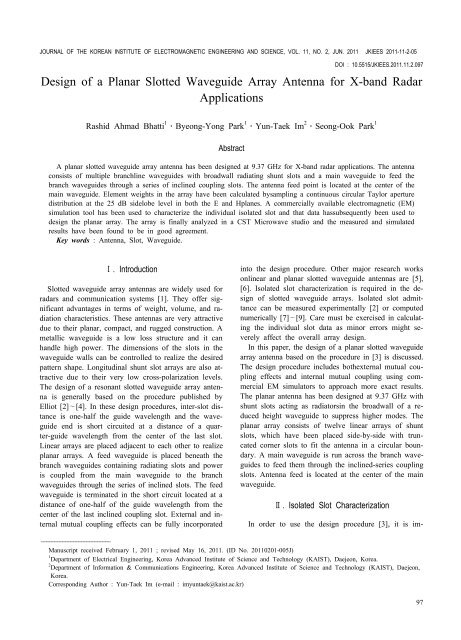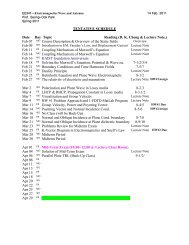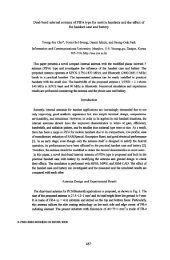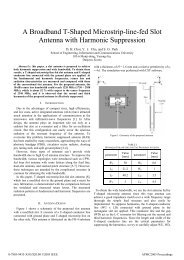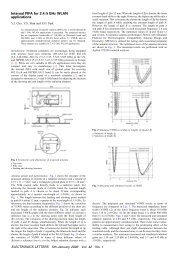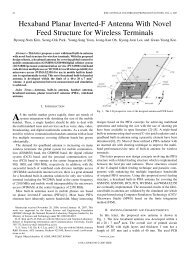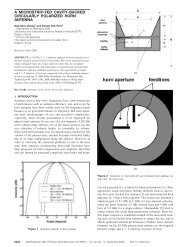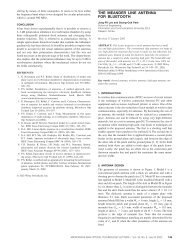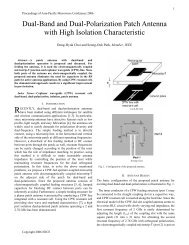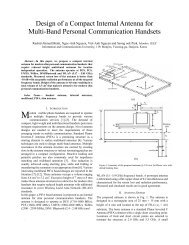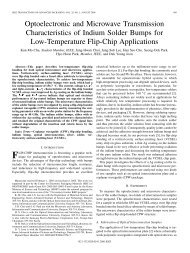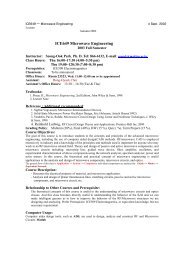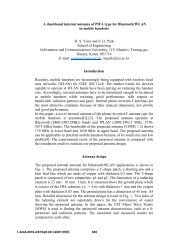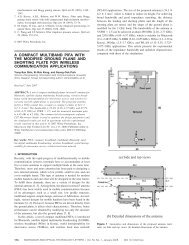Design of a Planar Slotted Waveguide Array Antenna for X-band ...
Design of a Planar Slotted Waveguide Array Antenna for X-band ...
Design of a Planar Slotted Waveguide Array Antenna for X-band ...
- No tags were found...
You also want an ePaper? Increase the reach of your titles
YUMPU automatically turns print PDFs into web optimized ePapers that Google loves.
JOURNAL OF THE KOREAN INSTITUTE OF ELECTROMAGNETIC ENGINEERING AND SCIENCE, VOL. 11, NO. 2, JUN. 2011 JKIEES 2011-11-2-05DOI : 10.5515/JKIEES.2011.11.2.097<strong>Design</strong> <strong>of</strong> a <strong>Planar</strong> <strong>Slotted</strong> <strong>Waveguide</strong> <strong>Array</strong> <strong>Antenna</strong> <strong>for</strong> X-<strong>band</strong> RadarApplicationsRashid Ahmad Bhatti 1 ․Byeong-Yong Park 1 ․Yun-Taek Im 2 ․Seong-Ook Park 1AbstractA planar slotted waveguide array antenna has been designed at 9.37 GHz <strong>for</strong> X-<strong>band</strong> radar applications. The antennaconsists <strong>of</strong> multiple branchline waveguides with broadwall radiating shunt slots and a main waveguide to feed thebranch waveguides through a series <strong>of</strong> inclined coupling slots. The antenna feed point is located at the center <strong>of</strong> themain waveguide. Element weights in the array have been calculated bysampling a continuous circular Taylor aperturedistribution at the 25 dB sidelobe level in both the E and Hplanes. A commercially available electromagnetic (EM)simulation tool has been used to characterize the individual isolated slot and that data hassubsequently been used todesign the planar array. The array is finally analyzed in a CST Microwave studio and the measured and simulatedresults have been found to be in good agreement.Key words : <strong>Antenna</strong>, Slot, <strong>Waveguide</strong>.Ⅰ. Introduction<strong>Slotted</strong> waveguide array antennas are widely used <strong>for</strong>radars and communication systems [1]. They <strong>of</strong>fer significantadvantages in terms <strong>of</strong> weight, volume, and radiationcharacteristics. These antennas are very attractivedue to their planar, compact, and rugged construction. Ametallic waveguide is a low loss structure and it canhandle high power. The dimensions <strong>of</strong> the slots in thewaveguide walls can be controlled to realize the desiredpattern shape. Longitudinal shunt slot arrays are also attractivedue to their very low cross-polarization levels.The design <strong>of</strong> a resonant slotted waveguide array antennais generally based on the procedure published byElliot [2]~[4]. In these design procedures, inter-slot distanceis one-half the guide wavelength and the waveguideend is short circuited at a distance <strong>of</strong> a quarter-guidewavelength from the center <strong>of</strong> the last slot.Linear arrays are placed adjacent to each other to realizeplanar arrays. A feed waveguide is placed beneath thebranch waveguides containing radiating slots and poweris coupled from the main waveguide to the branchwaveguides through the series <strong>of</strong> inclined slots. The feedwaveguide is terminated in the short circuit located at adistance <strong>of</strong> one-half <strong>of</strong> the guide wavelength from thecenter <strong>of</strong> the last inclined coupling slot. External and internalmutual coupling effects can be fully incorporatedinto the design procedure. Other major research worksonlinear and planar slotted waveguide antennas are [5],[6]. Isolated slot characterization is required in the design<strong>of</strong> slotted waveguide arrays. Isolated slot admittancecan be measured experimentally [2] or computednumerically [7]~[9]. Care must be exercised in calculatingthe individual slot data as minor errors might severelyaffect the overall array design.In this paper, the design <strong>of</strong> a planar slotted waveguidearray antenna based on the procedure in [3] is discussed.The design procedure includes bothexternal mutual couplingeffects and internal mutual coupling using commercialEM simulators to approach more exact results.The planar antenna has been designed at 9.37 GHz withshunt slots acting as radiatorsin the broadwall <strong>of</strong> a reducedheight waveguide to suppress higher modes. Theplanar array consists <strong>of</strong> twelve linear arrays <strong>of</strong> shuntslots, which have been placed side-by-side with truncatedcorner slots to fit the antenna in a circular boundary.A main waveguide is run across the branch waveguidesto feed them through the inclined-series couplingslots. <strong>Antenna</strong> feed is located at the center <strong>of</strong> the mainwaveguide.Ⅱ. Isolated Slot CharacterizationIn order to use the design procedure [3], it is im-Manuscript received February 1, 2011 ; revised May 16, 2011. (ID No. 20110201-005J)1 Department <strong>of</strong> Electrical Engineering, Korea Advanced Institute <strong>of</strong> Science and Technology (KAIST), Daejeon, Korea.2 Department <strong>of</strong> In<strong>for</strong>mation & Communications Engineering, Korea Advanced Institute <strong>of</strong> Science and Technology (KAIST), Daejeon,Korea.Corresponding Author : Yun-Taek Im (e-mail : imyuntaek@kaist.ac.kr)97
JOURNAL OF THE KOREAN INSTITUTE OF ELECTROMAGNETIC ENGINEERING AND SCIENCE, VOL. 11, NO. 2, JUN. 2011portant to generate isolated slot admittance as a function<strong>of</strong> slot length and the resonant length <strong>of</strong> the slot as afunction <strong>of</strong> its <strong>of</strong>fset. For feed slots, the resonant length<strong>of</strong> the slot as a function <strong>of</strong> its tilt angle is also required<strong>for</strong>the design <strong>of</strong> the array. A commercially available EMsimulation tool, HFSS, has been used to generate the basicslot data subsequently used in the array design. Inthe HFSS simulations <strong>for</strong> the shunt slot, the roundended 2.5 mm wide slot was created in a 1 mm thickbroadwall and admittance was recorded at a distance <strong>of</strong>one-half the guide wavelength from the center <strong>of</strong> theslot; the waveguide was terminated in a short circuitplaced at a quarter-wave distance from the center <strong>of</strong> theslot. Slot length was varied and at each step <strong>of</strong> normalizedcomplex admittance, conductance (G/G r ) and susceptance(B/G r), was recorded and was normalized withresonant conductance<strong>of</strong> the slot. The design curve thusgenerated is shown in Fig. 1. The real and imaginaryparts <strong>of</strong> the admittance are denoted as a h 1(y) and h 2(y),respectively, where y is the slot length normalized bythe resonant length, l/l r , which can be written as( , )Y x lG0( )= h ( y) + jh ( y) g( x)1 2The waveguide width and height are 21.5 mm and 5mm, respectively. Next, the slot <strong>of</strong>fset is changed and ateach step, the slot resonant length is calculated wherethe imaginary component <strong>of</strong> the admittance was zero.The resulting resonant length <strong>of</strong> the slot as a function<strong>of</strong> <strong>of</strong>fset is shown in Fig. 2.We will denote the curve shown in Fig. 2 as v(x),where x is the <strong>of</strong>fset <strong>of</strong> the slot from the center-line <strong>of</strong>the waveguide.Normalized resonant conductance, g ( x) = GrG0, <strong>of</strong>the isolated shunt slot as a function <strong>of</strong> <strong>of</strong>fset is plottedFig. 2. Resonant length <strong>of</strong> the broadwall slot versus <strong>of</strong>fset.in Fig. 3. The curve g(x) can be approximated as follows[7],2 æ p x ög ( x) = K sin ç ÷è a øa b 2 æ pb10 k0öK = 2.09 cos ç ÷b10 k0è 2 ø , (1)where a and b are the waveguide width and height respectively,and b10 is the propagation constant <strong>of</strong> TE 10mode and k0 = 2p l0.The coupling slot was also characterized in HFSS <strong>for</strong>its resonant resistance as a function <strong>of</strong> the tilt angle. Inthe simulation model, waveguide was terminated at thedistance<strong>of</strong> the half-guided wavelength from the center<strong>of</strong> the slot and resistance was recorded at the port locatedat thedistance <strong>of</strong> the half-guided wavelength fromFig. 1. Normalized admittance <strong>of</strong> isolated shunt slot versusslot length.Fig. 3. Normalized conductance <strong>of</strong> isolated shunt slot asa function <strong>of</strong> <strong>of</strong>fset.98
BHATTI et al. : DESIGN OF A PLANAR SLOTTED WAVEGUIDE ARRAY ANTENNA FOR X-BAND RADAR APPLICATIONS( b / )( )( / l ) 3K = j k k b a3 10 0k0lmn- jk0R1- jk0R2æ z'ömn 1 e egmnrscos4lk lmn/ 4lmn/ k R k R0 mn0 î íì éù= òç÷ · ê + úè l ø l-0 ë 0 1 0 2 ûk0lrs- jk0Ré 1 ù æ z'örs e ïü+ ê1- ú · cosdz'rs ýdz'mn ,4lrs/ç04lk lrs/÷ë l òûk R- 0 rsè l0ø 0where R is the distance from the point Pmn( 0,0, z ¢mn )measured in local coordinates at the center <strong>of</strong> the mn thslot to the point Prs( 0,0, z ¢rs ) measured in local coordinatesat the center <strong>of</strong> the rs th slot. l mn and l rs representthe slot length <strong>of</strong> mn th and rs th , respectively.ïþFig. 4. Resonant length <strong>of</strong> the series coupling slot as afunction <strong>of</strong> tilt angle.the center <strong>of</strong> the slot. At each tilt angle, the slot lengthwas varied to make the imaginary component <strong>of</strong> the slotimpedance equal to zero. The resulting curve is shownin Fig. 4.Ⅲ. <strong>Planar</strong> <strong>Array</strong> <strong>Design</strong> ProcedureThe antenna design rests on the following designequation [2].YGamn0where,Kand,f1mn= K f1mn( )VVsmnm0 10( k k )1 20=j a l hG ( b / k)( ka)( kb)( 2 ) cos( 10 )2 2( p 2kl) - ( b k )p klmn b lmn æ p xmnö= -Ksin ç ÷ .è a ømn10(2)éR x x z zë2( mn pq ) ( mn pq )æzz öùç ÷ úèøûpq= - +mnê - + -k0 k0R 2 is the distance from P mn to the left end <strong>of</strong> the slotPrs( 0,0, - lrs) and R 1 is the distance from P mn to the rightend <strong>of</strong> the slot, Prs( 0,0, lrs ) and is given as,2 é( ) ( )zmnùR1= xmn - xpq + zmn zæpqlöê- + ç -kpq ÷ëè ú0 øû2 é( ) ( )zmnùR2= xmn - xpq + zmn zæpqlöê- + ç +kpq ÷ëè ú0 øûThe typical configuration <strong>of</strong> the two slots in an arrayis given in Fig. 5.In (3), MC mn is the mutual coupling term <strong>for</strong> the mn thslot, which incorporates interactions from all <strong>of</strong> the slotsin the array.The aperture distribution has been calculated by samplingthe continuous aperture at slot locations <strong>for</strong> the —25dB first sidelobe level.The planar array is depicted in Fig. 6. It consists <strong>of</strong>a twelve branch waveguide witha feed waveguide placedZpq222In equation (2), V m is the mode voltage in the m thsbranch waveguide and Vmn is the slot voltage <strong>of</strong> themn th slot. Y is the active admittance <strong>of</strong> the mn th slot.YGamn0=amn2fmn ( xmn lmn)( )22 fmn xmn,lmn02 ,Y xmn lG( , )mn+ MCmn(3)x mnξ2l mnςR 2RR 12l pqxw<strong>Waveguide</strong> center lineVMC K g x l x lR S srsmn=3å å s mnrs mn mn rs rsr= 1 s= 1 Vmnrs ¹ mn( , , , )Z mnFig. 5. Two slots in a planar array.99
JOURNAL OF THE KOREAN INSTITUTE OF ELECTROMAGNETIC ENGINEERING AND SCIENCE, VOL. 11, NO. 2, JUN. 2011Fig. 7. Aperture distribution <strong>for</strong> the planar array withtruncated corner elements.Fig. 6. <strong>Planar</strong> slotted waveguide array antenna.behind.For the mn th slot in the array, the distance from theorigin is calculated as [9],100( 2 -1) ( 2 -1)ææ m dz ö 2 æ n dx ö2 örmn= ç ÷ + ç ÷ç è 2 ø è 2 ø ÷è ø ,where dx and dz are the inter-element spacing along xand z directions.The aperture distribution is then calculated as follows[9],whereA g p( )mn=0 mn , (4)p mnpr=amn2 S Jg( p)= åpSn -1n 02 20 J0( pmn)( pm )n -12mÕ 1-2n=1 unm= J0( pmm )èn -12æ mmÕ 1-2n 1 è unm nm 0næ m öç ÷øöç ÷= ø¹>m are zeros <strong>of</strong> ( ), S0= 1 ,where mJ1p u .The calculated aperture distribution is depicted in Fig. 7.A 3-D array factor plot corresponding to the sampledaperture distribution is shown in Fig. 8.Fig. 8. <strong>Array</strong> factor corresponding to the calculated aperturedistribution.After calculating the array weights, the following procedureis used to calculate the slot dimensions (<strong>of</strong>fsetsand lengths).A set <strong>of</strong> initial <strong>of</strong>fsets and lengths is assumed <strong>for</strong> theradiating slots. Resonant lengths and zero <strong>of</strong>fset are areasonable choice <strong>for</strong> starting the design. These <strong>of</strong>fsetsand lengths are used to calculate the following mutualcoupling termin equation (3),VMC K g x l x lR S srsmn=3å å s mnrs mn mn rs rsr= 1 s= 1 Vmnrs ¹ mn<strong>for</strong> every mn in the array.( , , , )Asearch is then conducted to find the couplet ( xmn,lmn)( , )xmnlmn that satisfies the following relation,
BHATTI et al. : DESIGN OF A PLANAR SLOTTED WAVEGUIDE ARRAY ANTENNA FOR X-BAND RADAR APPLICATIONSéùê 22 fmn ( xmn,lmn) úIm ê ú = - Imê Y( xmn,lmn ) úêëG ú0 û[ MC ]where Y/G 0 is calculated from the design curves, as( , l )Y xmnG0mnmn( h1 ( ymn ) h2( ymn )) g ( xmn)= + .Once this is satisfied, then active admittance <strong>of</strong> theslot become spure real. During this search process, acontinuum <strong>of</strong> couplets that satisfy this relation is found.Similarly, <strong>for</strong> the pq th slot, the same search is conductedand the continuum <strong>of</strong> couplets that make the active admittancepure real is found. But <strong>for</strong> a given acceptablecouplet <strong>for</strong> the mn th slot, there will only be one couplet<strong>for</strong> the pq th slot that will satisfy the following equation,Yapq2sf ( , )0 pqxpq lpq VpqVma 2smn mn ( mn,mn ) mn pG= .Y f x l V VG0This procedure provides a set <strong>of</strong> acceptable couplets<strong>for</strong> each slot. However, which couplet to choose will dependon the required admittance level in each branchline.The final acceptable couplets in a branch-line shouldsatisfy the relationship,YN ( m)amnå = Cm,n=1 G0where C m is the required admittance level in the m thbranch waveguide.The entire procedure needs to be iterated as the newslot data will give an improved mutual coupling calculationand the solution will converge after 3 or 4 iterations.After calculating the radiating shunt slot data, the seriesfeed slot data is then calculated according to the procedurereported in [9].The sum <strong>of</strong> the series <strong>of</strong> slot resistances is given by,Må r = W ,mm=1m= and m=1, 2…M,r m is the normalized resonant resistance <strong>of</strong> the m th slot,B is the slot excitation function, K is the excitation normalizationconstant, and W=1 <strong>for</strong> the end-feed or W=2<strong>for</strong> the center feed. B m is given in terms <strong>of</strong> the aperturedistribution.where r KB 2( m),(5)(6)(7)(8)N m2 2( ) ( , )B m = å A m n ,n=1where N m is the number <strong>of</strong> shunt slots fed by the m thseries slot.Using these resistance values, the corresponding slotangles are calculated using the design curves or the followingrelationship,(9)2R b10 l é l0g ù= 0.131 êIqsinq+ JqcosqúR0k ab ë 2aû , (10)where theta is the tilt angle <strong>of</strong> the series slot, andæ p ö æ p öcos K1 cos K2I ç ÷ ç ÷q 2 2=è ø±è øJ 1- K 1-Kq22 21 2K1 b10 l0= cosq± sinq.K k 2aOnce slot resistance as a function <strong>of</strong> the slot tilt angleis known, we can calculate the slot length <strong>for</strong> differentslot angles from the design curve shown in Fig. 4. Theapplied slot length (l) is 16.5 mm and the <strong>of</strong>fset lengths(x) are 2.1, 1.85, 1.6, 1.0, 0.8, and 0.7 mm after the calculationand CST-simulation.The feed waveguide is fed at the center through astandard X-<strong>band</strong> waveguide. The width <strong>of</strong> the feed slot isoptimized in CST to get the desired match at 9.375 GHz.A 3-D exploded model <strong>of</strong> the antenna assembly isshown in Fig. 9.Fig. 9. Exploded view <strong>of</strong> antenna assembly.101
JOURNAL OF THE KOREAN INSTITUTE OF ELECTROMAGNETIC ENGINEERING AND SCIENCE, VOL. 11, NO. 2, JUN. 2011Fig. 10. Surface currents on the aperture.Fig. 12. Comparison <strong>of</strong> the measured and simulated E-planepatterns.Fig. 11. Simulated 3-D pattern <strong>of</strong> the antenna.The surface currents on the plane containing the radiatingslots are depicted in Fig. 10. It can be observedthat the amount <strong>of</strong> current on the slots decreases withincreasing distance from the center <strong>of</strong> the antenna, thatexhibits amplitude tapering.A simulated 3-D pattern <strong>of</strong> the antenna is depicted inFig. 11.A comparison <strong>of</strong> the measured and simulated patternsis given in Fig. 12. The first sidelobe level <strong>of</strong> the antennais 25.6 dB down and the 3-dB beamwidth <strong>of</strong> the antennais 8.2 degrees. The measured gain <strong>of</strong> the antennais 26 dBi.A comparison <strong>of</strong> the measured and simulated reflectioncoefficients <strong>of</strong> the antenna is given in Fig. 13.The antenna shows a <strong>band</strong>width <strong>of</strong> 200 MHz <strong>for</strong> the —10dB input reflection coefficient. The radiation efficiencyis calculated as,2Gain ´ lEfficiency = , Area ´ 4pand efficiency <strong>of</strong> the antenna is 46 %.(11)Fig. 13. Comparison <strong>of</strong> the measured and simulated inputreflection coefficients.Ⅳ. ConclusionsA planar slotted waveguide antenna has been designedat 9.37 GHz using broadwall radiating slots. Theantenna design is based on the commonly used Elliot’sslotted waveguide antenna design procedure, using thecommercially available EM simulation tools, HFSS &CST MWS. The antenna has been designed <strong>for</strong> a —25dB sidelobe level and a beamwidth <strong>of</strong> 8.2°. Comparisons<strong>of</strong> the measured and simulated far-field patternsand input reflection coefficients have been reported, andshow amaximum 10 dB error within the measured<strong>band</strong>widthdueto loss or leakage in thewaveguide adapter.102
BHATTI et al. : DESIGN OF A PLANAR SLOTTED WAVEGUIDE ARRAY ANTENNA FOR X-BAND RADAR APPLICATIONSThis research was financially supported by the Ministry<strong>of</strong> Education, Science Technology (MEST) andKorea Institute <strong>for</strong> Advancement <strong>of</strong> Technology (KIAT)through the Human Resource Training Project <strong>for</strong>Regional Innovation.References[1] Phillip N. Richardson, H. Y. Lee, "<strong>Design</strong> and analysis<strong>of</strong> slotted waveguide arrays," Microwave Journal,pp. 109-125, Jun. 1988.[2] Robert S. Elliot, L. A. Kurtz, "The design <strong>of</strong> smallslot arrays," IEEE Trans. <strong>Antenna</strong>s Propagation, vol.AP-26, pp. 214-219, Mar. 1978.[3] Robert S. Elliot, "An improved design procedure <strong>for</strong>small arrays <strong>of</strong> shunt slots," IEEE Trans. <strong>Antenna</strong>sPropagation, vol. Ap-31, pp. 48-53, Jan. 1983.[4] Robert S. Elliot, W. R. O’Loughlin, "The design <strong>of</strong>slot arrays including internal mutual coupling," IEEETrans. <strong>Antenna</strong>s Propagation. vol. Ap-34, pp. 1149-1154, Sep. 1986.[5] H. Y. Yee, "The design <strong>of</strong> large waveguide arrays<strong>of</strong> shunt slots," IEEE Trans. <strong>Antenna</strong>s Propagation,vol. 40, no. 7, pp. 775-781, Jul. 1992.[6] Alan J. Sangster, A. H. I. McCromick, "Theoreticaldesign and synthesis <strong>of</strong> slotted waveguide arrays,"IEE Proc. H. Microwaves, <strong>Antenna</strong> and Propagation,vol. 136, no. 1, Feb. 1989.[7] George J. Stern, R. S. Elliot, "Resonant length <strong>of</strong>longitudinal slots and validity <strong>of</strong> circuit representation:theory and experiments," IEEE Trans. <strong>Antenna</strong>sPropagation, vol. Ap-33, no. 11, pp. 1264-1271, Nov.1985.[8] Lars G. Josefsson, "Analysis <strong>of</strong> longitudinal slots inrectangular waveguides," IEEE Trans. <strong>Antenna</strong>s Propagation,vol. AP-33, pp. 1351-1357, Dec. 1987.[9] Robert S. Elliot, <strong>Antenna</strong> Theory and <strong>Design</strong>, No. 6,Prentice Hall, Inc, 1981.Rashid Ahmad Bhattiwas born in Bahawal-Nagar, Pakistan, onJuly 14, 1975. He received the B.Sc. degreein electrical engineering from University<strong>of</strong> Engineering and Technology, Taxila,in 1999 and the M.Sc. degree in electricalengineering from National University <strong>of</strong>sciences and Technology (NUST), Rawalpindi,Pakistan, in August, 2005. Currentlyhe isworking toward the Ph.D. degree in electrical engineering atthe Korea Advanced Institute <strong>of</strong> Science and Technology(KAIST), Daejeon, Korea. From September 1999 to December2005, he worked as an RF and <strong>Antenna</strong> Research Engineer atAdvanced Engineering Research Organization (AERO), Pakistan.Here, he has been involved in the EMI/EMC testing anddesign <strong>of</strong> slotted waveguide array antennas <strong>for</strong> trackingradars.His current research interests include the design <strong>of</strong> MI-MO antennaarrays, multi<strong>band</strong> antennas <strong>for</strong> portable communicationdevices, slotted waveguideantennas and numerical methodsin electromagnetics.Byeong-Yong Parkwas born in Daejeon, Korea. He receivedthe B.S. degree in division <strong>of</strong> electricalengineering from ChungNam NationalUniversity, Korea, in 2008, the M.S. degreein electrical engineering from Korea AdvancedInstitute <strong>of</strong> Science and Technology(KAIST), Daejeon, Korea, in 2010, and iscurrently working toward the Ph.D. degreein electrical engineering atKorea Advanced Institute <strong>of</strong>Science and Technology (KAIST), Daejeon, Korea. His currentresearch interest is the design <strong>of</strong> MIMO antenna arrays<strong>for</strong> portable communication devices.103
JOURNAL OF THE KOREAN INSTITUTE OF ELECTROMAGNETIC ENGINEERING AND SCIENCE, VOL. 11, NO. 2, JUN. 2011Yun-Taek Imwas born in ChungNam, Korea, on June7th, 1978. He received the B.S. degreeindivision <strong>of</strong> electrical engineering and computerscience from Hanyang University,Korea, in 2005, the M.S. degree in electronicand electrical engineering from thePohang University Science and Technologyat Pohang (POSTECH), in 2007, andis currently workingtoward the Ph.D. degree in electrical engineeringat the Korea Advanced Institute <strong>of</strong> Science andTechnology (KAIST), Daejeon, Korea. He was engaged in development<strong>of</strong> RFID antennas and millimeter-wave beam-<strong>for</strong>mingsystems from 2005 to 2007. His current research interestsare MIMO antenna systems and radar systems including antennadesign.Seong-Ook Park(M’05) was born in KyungPook, Korea,in December 1964. He received the B.S.degree from KyungPook National university,in 1987, the M.S. degree from KoreaAdvanced Institute <strong>of</strong> Science and Technology,Seoul, in 1989, and the Ph.D.degree from Arizona State University, Tempe,in 1997, all in electrical engineering. FromMarch 1989 to August 1993, he was aResearch Engineer withKorea Telecom, Daejeon, working with microwave systemsand networks. He later joined the Telecommunication ResearchCenter, Arizona State University, until September 1997.Since October 1997, he has been with the In<strong>for</strong>mation andCommunications University, Daejeon, first as an AssociatePr<strong>of</strong>essor, and currently as a Pr<strong>of</strong>essor at the Korea AdvancedInstitute <strong>of</strong> Science and Technology, IT convergence Campus.His research interests include mobile handset antenna, and analyticaland numerical techniques in the area <strong>of</strong> electromagnetics.Dr. Park is a member <strong>of</strong> Phi Kappa Phi.104


